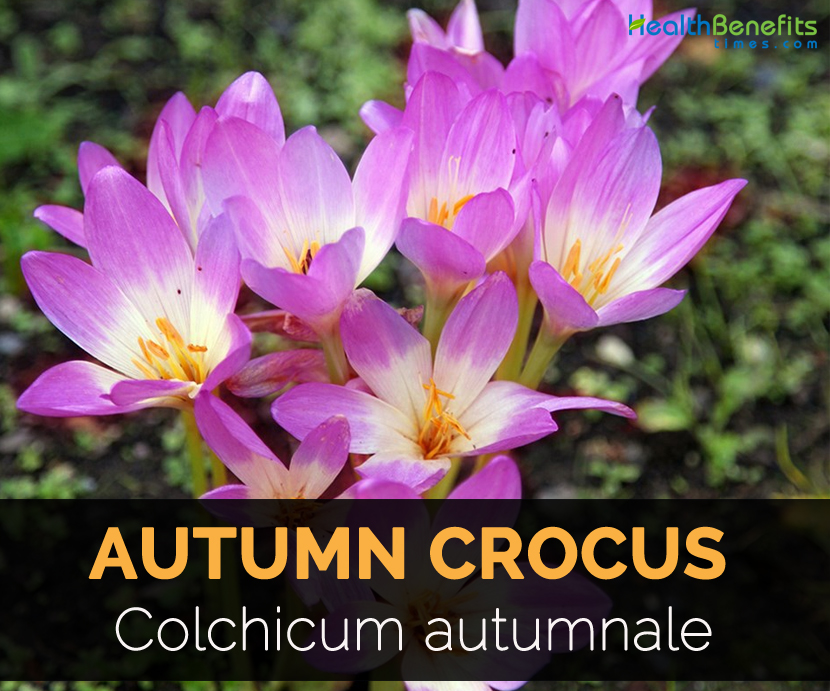| Autumn Crocus Quick Facts | |
|---|---|
| Name: | Autumn Crocus |
| Scientific Name: | Colchicum autumnale |
| Name | Autumn Crocus |
|---|---|
| Scientific Name | Colchicum autumnale |
| Common/English Name | Wild Saffron, Meadow Saffron, Naked Boy, Naked Lady, and Son before the Father |
| Name in Other Languages | German: Herbst-Zeitlose; Lithuanian: Rudeninis vėlyvis; English: Autumn crocus, Autumn-crocus, Colchicum, Meadow-saffron, Meadow saffron; Arabic: ʿAkna (عَكنه), Hafer el mohar (حافر المهر), lhelah kheryefy (لحلاح خريفي), Khamira, Qatel el kelb (قاتل الكلب), Sewrenjan alekheryef (سورنجان الخريف), Sourendjan (سورنجان); Bulgarian: Obiknoven mrazovets (Обикновен мразовец); Catalan: Còlquic; Chinese: Qiū shuǐ xiān (秋水仙); Czech: Ocún jesenní, Ocún podzimní; Danish: Høsttidløs, Høst-Tidløs; Dutch: Herfsttijloos, Wilde Herfsttijloos; Finnish: Syysmyrkkylilja; French: Chenarde, Colchique d’automne, Dame-nue, Dame-sans-chemise, Femme-nue, Mort-aux-chiens, Oignon de loup, Safran bâtard, Tue-chien, Tue-loup, Veilleuse, Veillotte; German: Herbstkunkel, Herbstlilie, Herbstzeitlose, Herbst-Zeitlose, Nackte Jungfer, Nackte Kath, Wiesen-Safran, Wiesen-Lilie; Greek: Kolchikó to fthinopo̱rinó (Κολχικό το φθινοπωρινό), Kolchikó fthinopo̱rinó (Κολχικό φθινοπωρινό); Hebrew: קולכיקומ, Qolkhyqom (סתוונית שווא); Hungarian: Őszi kikerics, Őszi krókusz; Italian: Colchico autumnale, Colchico d’autunno, Freddoline, Narciso autumnale, Strozzacane, Zafferano selvatico; Japanese: Inusafuran (イヌサフラン), Koruchikamu (コルチカム); Norwegian: Tidlaus, Tidløyse Polish: Zimowit jesienny Portuguese: Açafrão-bastardo, Acáfrão-do-prado, Cebola venenosa, Cólchico, Narciso-de-outono; Russian: Bezvremennik osennij (Безвременник осенний); Slovakian: Jesienka obyčajná, Ocún jesenní ; Slovenian: Jesenski podlesek; Spanish: Azafrán silvestre, Cólquico, Cólquico común, Cólquico de otoño, Despachapastores, Quitameriendas, Vellorita; Swedish: Hösttidlösa, Nakna jungfrun, Tidlösa, Vanlig tidlösa; Turkish: Aci çiğdem, Güz çiğdemi, Itboğan, Sonbahar çiğdemi; Ukrainian: Пізньоцвіт осінній Piznʹotsvit osinniy̆; Urdu: سورنجان Vietnamese: Bả chó, Cây bả chó |
| Plant Growth Habit | Herbaceous perennial |
| Leaf | 25 cm (10 in) long |
| Flowering Season | August to October |
| Flower | Purple, 4–7 cm (2–3 in) across |
Plant description
Autumn Crocus is a perennial plant belonging to Lily family Lilium convallium and Veratrum. It is grown in most parts of the temperate areas of Europe, America and Asia and growing wild in moist meadows. The corm is a white, bulbous mealy like mass about 3 cm wide by 5 cm high which is covered with a brownish red tunic. Leaves are 25 cm long and flowers are solitary, 4–7 cm (2–3 in) across with six tepals and six stamens with orange anthers and three white styles.
Flower
Stalk is 4-6 inches long with single globet shaped flowers which lasts for upto 2 weeks. Flowers are 2 inches wide which emerges from the ground long after the leaves have diet back. Primarily a light pink purple color and have white flowers. Flowers have six stamens rather than three stamens of the crocus. Autumn Crocus has large, globet shaped, fragrant flowers which are 5 inches tall and have white throat.
Medicinal uses
- It is used to provide relief from nausea, pain and inflammation of acute gout and rheumatism.
- Seeds and corm are analgesic, cathartic, antirheumatic and emetic.
- For gout, take rind seeds of Autumn Crocus with water once a day.
- For rheumatism, apply a paste of Autumn Crocus with 3-4 buds of saffron and egg.
- For wounds, sprinkle root powder of Autumn Crocus over the wounds two times a day.
Precautions
- It may cause vomiting, serious inflammation of stomach, bowels, violent purging and death.
- The corms can cause skin allergies in some people.
- It can cause burning of mouth, throat, diarrhea, vomiting, liver and kidney problems, nerve problems, blood disorders, organ failure, shock and death.
References:
https://www.itis.gov/servlet/SingleRpt/SingleRpt?search_topic=TSN&search_value=42907#null
https://pfaf.org/user/Plant.aspx?LatinName=Colchicum+autumnale
https://journals.sagepub.com/doi/pdf/10.1177/104063871002200125
http://www.naturalmedicinalherbs.net/herbs/c/colchicum-autumnale=autumn-crocus.php
https://herbpathy.com/Uses-and-Benefits-of-Colchicum-Autumnale-Cid2909
https://www.naturalmedicinefacts.info/plant/colchicum-autumnale.html
https://practicalplants.org/wiki/Colchicum_autumnale


